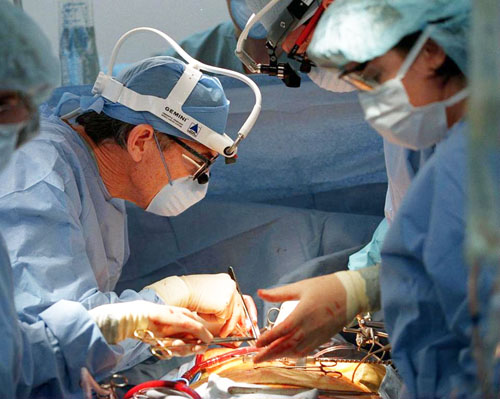Dr Arvind Kohli
Cardiac surgery has continued to evolve and advances have resulted in improved and durable outcomes in a higher risk population. We now have surgical options to disease processes traditionally treated with medical therapy.
One of the major advances in coronary revascularization has been the development of beating heart bypass surgery. The recent developments in minimally invasive surgery include robotic surgery and the enabling technologies such as the anastomotic devices and those aimed at lessening aortic manipulation. The surgical management of heart failure is rapidly advancing with the options of passive and active constraint, ventricular restoration and biventricular pacing through placement of left lateral free wall leads. Gene therapy and cell transplantation are also being studied and applied in the treatment of cardiac disease and ventricular assist devices are now being used for destination therapy. Mitral valve repair is the preferable established treatment for mitral regurgitation when possible and advances are being made in this approach on the beating heart. Atrial fibrillation ablation by less invasive approaches is now routinely performed in the operating room with varying types of energy sources.
In the past decade, minimally invasive surgical techniques have become prevalent in the field of cardiac surgery, including minimally invasive direct coronary artery bypass (MIDCAB), off-pump coronary artery bypass (OPCAB), and minimal access atrial septal defect (ASD) closure and mitral and aortic valve surgery. In addition to the development of new technologies such as visualisation systems, specially designed retractors, stabilisers and alternative methods of vascular cannulation and cardiopulmonary bypass, surgeons have become capable of performing simple cardiac procedures through much smaller incsions than with conventional approaches. However, the limited incision size has imposed a corresponding increase in the technical difficulty of the procedure accompanies by a potential for a reduced safety margin due to incomplete cardiac exposure.
Robotic Assisted Cardiac Surgery
Recently, robotically assisted surgical systems have been introduced to increase the precision of endoscopic surgery and facilitate minimally invasive cardiac surgery. These computer-gjided systems can control both surgical instruments and endoscopic cameras. Robotic instrumentation rovides access to the heart and offers the surgeon the ability to operate precisely in limited spaces, overcoming the lack of precision that results from the additive effects of instrument length and operator tremor by filtering high-frquency motion. Dexeterity is further enhanced through compter motion-scaling, which allows the surgeon to make large, easy-to-perform macroscopic movements at the console and have these movements scaled down by the computer to micrsopic movements of the instrument tip inside the patient. Endoscopic magnification also improved the accuracy of surgical maneuvers by providing enhanced visualization.
All the robotically assisted cardiac surgery procedures performed to date have either been extra-cardiac procedures or procedures that were performed inside an arrested heart. In the past, beating -heart procedures were attempted, but these approaches fell into disfavor after cardiopulmonary bypass (CPB) became available, which allowed direct visualization of the intra-cardiac structures. Nevertheless, CPB is widely recognized as having a number of adverse effects, including the generation of microemboli and an inflammatory response, which together can result in neurological dysfunction in adults and neuro developmental dysfunction in children.
However the recently introduced real-time three-dimensional echocardiography (RT3DE) provides clinicians and surgeons with a new perspective for visualising the heart non-invasively. When RT3DE is used for image-guided surgical tasks, some complex tasks required for intra-cardiac repair can be performed using echo guidance alone. This system has sufficient spatial resolution and frame rate to give the surgeon a “virtual surgon’s view’’ of the relevant anatomy and further advancements in this can enable Cardiac surgeons to go for beating heart procedures.
Gene Therapy in Cardiac Surgery
The concept of gene therapy was introduced in the 1970s after the development of recombinant DNA technology. Despite the initial great expectations, this field experienced early setbacks. Recent years have seen a revival of clinical programmes of gene therapy in different fields of medicine. There are many promising targets for genetic therapy as an adjunct to cardiac surgery. The first positive long-term results were published for adenoviral administration of vascular endothelial growth factor with coronary artery bypass grafting. The primary existing clinical trial approaches in cardiac surgery are therapeutic angiogenesis for coronary artery disease as well as the pretreatment of vein grafts before coronary artery bypass grafting (CABG) to prevent graft failure. Promising directions include concomitant genetic treatment with cardiac surgery for low ejection fraction in Chronic intractable Heart failure, as well as advances in cardiac transplantation and correction of atrial fibrillation and other types of arrthythmias.
Trans Aortic Valve Replacement
TAVR or TAVI stands for transcatheter aortic valve replacement. It is an exiciting technology that allows physicians to fix a severely narrowed aortic valve (aortic stenosis) without opening up the patient’s chest.
Currently, this is an option for patients with severe aortic stenosis causing symptoms that are too high risk for standad valve replacement surgery.
During a TAVI or TAVR procedure, a catheter about the size of a pen, is inserted in the artery in the leg and carefully passed up into the heart. One type of TAVR valve, made of bovine( cow) tissue and supported on a metal stent, is then implanted inside the narrowed valve resulting in a normal functioning aortic valve. With a TAVR procedure, the patient does not need the chest opened for surgery or put on a heart-lung (bypass) machine.
Is TAVI/TAVR safe ?
The TAVI/TAVR procedure has been done in over 50,000 patients worldwide. In the research trials evaluating TAVI/TAVR, it was shown to significantly allow patients to live longer and with better quality of life jwhen compared to treating with medicines only. As with any heart procedure, TAVI/TAVR has its own risks. These risks can be discussed with cardiac surgeon as TAVI has specific indications.
The option of surgical treatment for cardiac disease is expanding rapidly and should be offered to patients so that they can get the best care available.
(The author is Cardiac Surgeon SSH Jammu)
Trending Now
E-Paper


